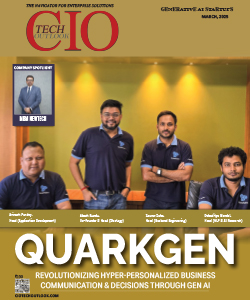Optimizing Industry Decision-Making through Simulation, HPC, and AI
Vishwanath Rao, MD & Country Manager - India & GCC, Altair

In an interaction with CIOTechOutlook, Vishwanath shared his insights on the role of simulation, high-performance computing (HPC), and artificial intelligence (AI) in the decision-making process and more.
Having completed his mechanical engineering degree from PESIT Bangalore and holding a PG diploma in management from Symbiosis Institute of Business Management, Vishwanath has been associated with Altair for over 24 years and has been instrumental in the company’s growth.
Explain the role of simulation, high-performance computing, and AI in the decision-making process.
Having started off as merely a forensic tool to understand the causes behind a product or part failure, simulation has now become a crucial technology that’s been in use for the last four decades. Today, as a verification/validation tool, simulation enables users to look at results before designing/developing a prototype, thus enabling teams to understand performance and make design changes as necessary. Simulation is also used as a design tool thereby enabling companies to design optimized products in the first instance, saving time and costs. AI has only made things better and faster, further reducing development times and allowing more design and material options in the process. Both simulation and AI are computationally intensive since they require solving mathematical problems that require computational infrastructure. This is where HPC comes into the picture.
How can organizations effectively harness the power of simulation, high-performance computing, and AI to drive innovation and adapt to changing industry dynamics?
Simulation empowers users to model any physical phenomena, thus enabling them to solve problems that would otherwise be challenging or even impossible. These problems can be solved in a shorter time duration by leveraging other technologies, such as HPC, parallel processing, and more. The scope of simulation has also broadened recently, encompassing electronics, computational fluid dynamics (CFD), discrete elements, and beyond. The power of simulation is further augmented by AI; the data created by simulation can be used to build AI/machine learning models and deployed to provide meaningful insights faster than ever before. These technologies are vertical agnostic and almost all industries dealing in product development can and should take advantage of them.
What ethical considerations should be considered when applying AI and simulation technologies to diverse industries?
Simulation on its own is a computational representation of a physics problem and its solved outcome; it does not make any design and engineering decisions on your behalf – and therefore is devoid of any ethical concerns. Even introducing AI at this stage does not present an immediate challenge, though future product development might. However, AI as part of the product operation – where the algorithm starts making decisions on the user’s behalf – then we see ethical considerations enter the picture. Building models requires an unbiased approach and the right kind of data to train them. Failing to provide these aspects can be unsafe and even dangerous. Explainable AI mitigates this problem by bringing much-needed transparency to analyze the kind of data and algorithms in use. Since you are allowing AI to make decisions on your behalf, you must ensure that there is no bias in the decision-making process.
How can interdisciplinary collaboration be encouraged to foster innovative solutions at the intersection of these technologies?
There was a time when we had pure-play mechanical devices; a scooter or any other vehicle 30 years ago was often comprised of nothing more than a few mechanical systems. Today, vehicles are probably more software than mechanical. For instance, if you look at a modern electric vehicle (EV), it’s comprised of everything from electronics to software, electrical systems, mechanical systems, communication systems, and more. All these systems are working together to deliver the desired performance and capabilities. This is a perfect example of interdisciplinary collaboration, and the scope of such will only increase going forward.
What potential should organizations be aware of while exploring newer opportunities that these technologies might offer?
We must keep in mind that simulation and AI are not designed to replace people; they are designed to augment human intelligence, which will continue to play the primary role in all crucial decision-making processes. I believe that people should continue to trust their own engineering capabilities and use AI and simulation for guidance, much like a frame of reference and verification tool.




